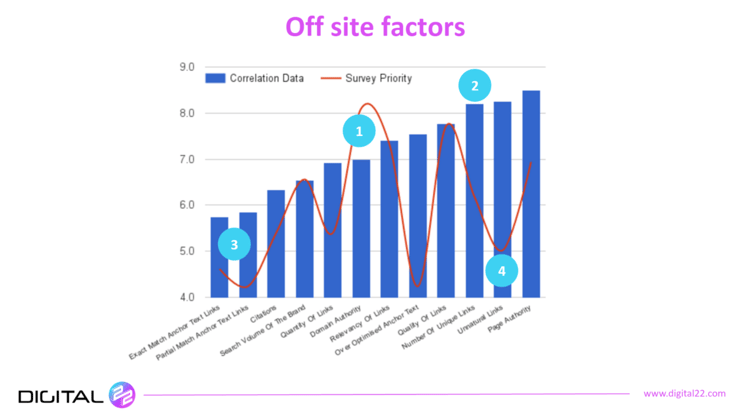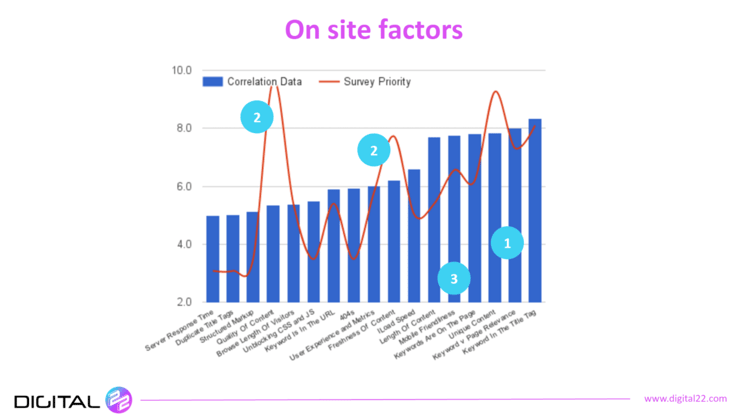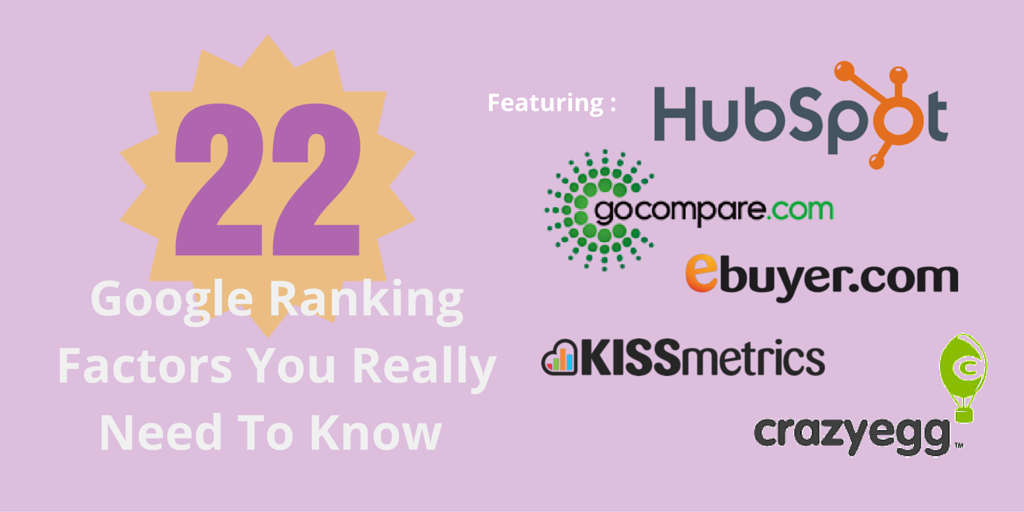You often hear about Google's 200+ ever changing ranking factors and the challenges these present...
Cut through the hyperbole, scaremongering and false proclamations with this statistical analysis of what really is the truth about SEO in 2016. No nonsense, just honest facts.

Ignoring The Hype
At the same times as many blogs and agencies might periodically try and tell us that "SEO is dead!", there are countless more which try to get ahead of the curve (which is good) by trying to preempt the next big sea change in search engine optimisation. But it's often based on nothing more than gut feeling and popular thinking (which is risky at best and damaging at worst).
From over the past 18 months, or so, here are some widely popular trains of thought which swept across the SEO world. We won't link any posts specifically, as I'm sure all blogs were posted in all sincerity and, besides, let's be honest, I'm sure we don't have a faultless prediction record!
Anyway, here are just a selection of popular SEO predictions from the recent past:
- "Google Glass will change search forever"
- "SEO is all about content"
- "Wearable Tech will disrupt search"
- "Forget keyword research and start topic modelling"
- Why you need semantic connectivity"
And we are NOT saying any of these ideas were wrong to base your SEO strategy on. The point is that they are purely ideas and you should never stop doing what already works today on the off-chance something might work better in the future.
I mentioned that we might not have a faultless record when it comes to predictions, but what we do have (and massively pride ourselves on) is only ever making assumptions, predictions and campaign decisions based on hard data.
With this in mind, let's start looking at what all the top ranking sites in 2016 have in common, to try and pinpoint what works in SEO in 2016, so you can make sure you are following current best practice.
We Are Looking At Correlation Data Between Moz's 2016 Findings And Our Own User Survey
Every couple of years, the team at Moz puts together an amalgamated data pack which aims to draw a correlation between all the factors which high ranking websites have in common.
At the same time, we have canvassed the attendants of our Manchester HubSpot User Group conference (both in-house and agency marketing professionals) and our database to find out what they are prioritising, seeing results with and other related factors.
The idea is to try and work out what - if anything - all high ranking websites, from various industries and backgrounds all have in common. This can then give clues as to what the search engines do and do not include in the ranking algorithms.
But, a quick disclaimer at this point is needed: these are just factors that high ranking sites have in common and may not be the cause of the high ranking itself. This is just our best estimate of how the algorithms currently work.
Off Site Factors Affecting SEO In 2016
Here are Moz's correlation data findings (blue bars) and our own survey responses averaged out (red line) to show how our survey respondents said what they prioritise.
The four key points are discussed below the graph.

- The survey data shows that (in-house and agency) digital marketers prioritise Domain Authority over Page Authority in their SEO practices. But Moz has found that Page Authority is the leading common ranking factor.
- The raw Number of Unique Links still outperforms Quality and Relevancy of Links. Not that the the two latter factors should be ignored, of course.
- It seems that all can agree that we shouldn't push Exact Match Anchor Text Links or even Partial Match Anchor Text Links. But one concern is that there is a big negative correlation between how many top ranking sites feature Over Optimised Anchor Text (5th most common) and it's the joint lowest priority of the marketers we surveyed.
- There is another big oversight when it comes to Unnatural Links. Moz have correlated it to be the second most common off-site factor to manage, but it's a very low priority of the marketers we surveyed. This is something to check with some regularity, in the future or if you inherit a site from an agency.
On Site Factors Affecting SEO In 2016
Moving on to site factors, we can see the Moz data, once again, in the blue bars and our survey data on the red line, averaged. The three key points are explained below.

- The leading correlating factors of the top ranking sites (Keyword In The Title Tag, Keyword v Page Relevance (i.e. Keyword Choice), Unique Content, and Keywords Are On The Page) are also what most marketers are prioritising. It shows solid keyword research is what underpins your SEO success in terms of on page optimisation.
- Two spikes on the survey data relate to Quality Of Content and Uniqueness Of Content. According to Moz's correlated data, we are putting too much emphasis on these areas, but our advice would be to keep prioritising these two areas because they ultimately lead to a better user experience and are user led. Which is how the search engines work and what Google have told us is their core focus: helping the user.
- Load Speed, Length Of Content and Mobile Friendliness are three leading common features of high ranking sites but they are relatively under prioritised by marketers. This might be because they are the most time (and therefore also budget) consuming, but (from the point of view of an agency or marketing department) we need to be afforded the resources to fully target these areas as they are so important.
Marketer Priorities vs Most Common High Ranking Factors
When you isolate what our surveyed marketers are stating as their top priorities and compare this to what Moz has found to be most apparent feature in the highest ranking sites, there is a real disconnect.
What Marketers Work On |
What Marketers Should Work On |
| 1. Quality Of Content | 1. Page Authority |
| 2. Unique Content | 2. Keyword In The Title Tag |
| 3. Domain Authority | 3. Removing Unnatural Links |
| 4. Keyword In The Title Tag | 4. Number Of Unique Links |
| 5. Quality Of Links | 5. Keyword vs Page Relevance |
The only commonality at the top of the two respective lists is the fact that Keywords In The Title Tag features. It should be noted this is only based on our and Moz's data, but it has struck a chord with the marketers we have spoken with.
The biggest takeaway from all of this, so far, is that links are still the major ranking factor for building your SERP ranking. And solid on page optimisation is what best tells the the search engine spiders what your page is about and which search queries it can answer.
This means, regardless of the hype and finger in the air predictions, the data suggests the algorithms haven't changed too much over the years and the basics of SEO still apply.
Where We Go From Here: SEO At The End Of 2016
Much was made about the growth of voice search, earlier in 2016. We blogged about it and so did everybody else.
From our non-too scientific straw polls and general user questioning, it seems that, alas, 2016 has NOT turned out to be the year of voice search. However, Think With Google data tells us that even if people aren't actually using the voice function itself, users are searching in a more "spoken" way, lexically speaking.
Mobile search continues to become the go-to search method. Whilst it has yet to become the mainstream technique (we do think it will, for what it's worth), voice searching on a mobile device is done in a long-tail form. When people speak to their device, they can't help but speak in a more natural way. It also appears that these search habits are being used in (text based) mobile search too.
And how you optimise for voice search in your content also makes for good inbound marketing. Three steps to optimising for voice search, to preempt it becoming more mainstream, whilst also making sure your content is inbound friendly and ready to attract visitors who are open to being nurtured into becomes leads and conversions, are:
1. Implement Long-Tail Keywords
As said, people who use voice search do so using long-tail keywords. And these also form the cornerstone of an effective inbound marketing strategy.
2. Cater For People Searching In FAQ Style
As more people search in a FAQ style ("Who is...", "Where can I...", "What do...", "How to..." and "Why do..."), via voice and typed search, you need to make your content answer these queries. They're good for targeting micro moments and for providing helpful inbound marketing content, highly focused on your target persona's needs.
3. Write Content In A Natural Voice
In both voice search and mobile search, people search in a more natural and slightly less formal language. Your content should match this in order to be engaging with them on a mutual level.
Why Good SEO Means Mobile First
In case you missed it, we are in a mobile first world. And, just for the avoidance of doubt, if you are not optimising for a mobile first SERP, you are losing traffic and everything else that follows this.
In a nutshell, here are some of the recent Google changes which show just how far mobile searches should be ahead of desktop in terms of focus:
- Accelerated Mobile Pages (AMP) results pages are now included in organic results.
- More searches take place on Mobile than Desktop (and have for a while).
- Google will be switching to a Mobile Results Index first over the Desktop Index it currently uses. This effectively means that you should create pages "mobile first" and optimise for desktop, as opposed to the traditional opposite tactic. Or, most simply, just use responsive design.
- Google Chrome has been making mobile friendly versions of pages. But they're Chrome's version, so don't rely on this and lose your CTAs or whatever else.
- Decisions like the devaluing in mobile results of sites with interstitials and pop-ups means that mobile considerations need even closer management.

This image (above) visually shows the point about designing for a mobile first world, and optimising for desktop accordingly. But, like most things SEO, it isn't so black and white in reality.
It is still best to design with multi-platform users in mind - especially considering how many users still complete tasks on mutiple formats (starting a task on one device and finishing it on another). Also, this habit is something which is likely to grow further as technology continues to make it easier to pick up where you left off on another device and hybrid devices (iPad Pro, Microsoft Surface, et al) improve and become mainstream.
Just like mentioned earlier with SEO generally, mobile SEO still relies on some best practice basics, if you want to perform as well as possible:
- Use Schema.org to make sure the spiders know best what your site is about, to best target rich results and command more SERP real estate. Read more about how to implement schema here and the latest news about what it can now be used for here.
- Make sure you optimise page speed for mobile devices on slow connections. But also implement AMP pages, minimise code, leverage browser caching and reduce redirects. Which all, in a nutshell, cater for user habits and aim to maximise UI and UX. I.e. just what Google says they want us to do.
- Optimise your Titles and Meta Descriptions to cater for users who are operating with less screen space. Get to the point and include keywords.
- Make it easy to move through the Buyer's Journey on mobile with your CTAs: tap to call, email, directions, engage on social.
And, One Last Time... SEO Is Not Dead
Even though there have been big changes, this year, with how the SERP looks; more paid ads, bigger answer boxes, rich snippets, ads between organic results, less organic results... users are searching more.
SEO therefore is not dead. There are more search queries for you to target and the traffic is continuing to grow. Make sure you're fully optimised.
Optimise Your SEO And Everything Else Inbound
So that is where SEO stands as we close 2016. To make sure your SEO, PPC, Content and everything else Inbound is operating as well as it possible can, check out our free guide to getting more from your inbound marketing. Press Get The Guide below...


